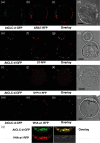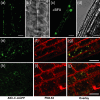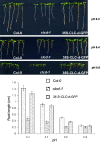Function of the anion transporter AtCLC-d in the trans-Golgi network
- PMID: 17376158
- PMCID: PMC1891005
- DOI: 10.1111/j.1365-313X.2007.03061.x
Function of the anion transporter AtCLC-d in the trans-Golgi network
Abstract
Anion transporting proteins of the CLC type are involved in anion homeostasis in a variety of organisms. CLCs from Arabidopsis have been shown to participate in nitrate accumulation and storage. In this study, the physiological role of the functional chloride transporter AtCLC-d from Arabidopsis was investigated. AtCLC-d is weakly expressed in various tissues, including the root. When transiently expressed as a GFP fusion in protoplasts, it co-localized with the VHA-a1 subunit of the proton-transporting V-type ATPase in the trans-Golgi network (TGN). Stable expression in plants showed that it co-localized with the endocytic tracer dye FM4-64 in a brefeldin A-sensitive compartment. Immunogold electron microscopy confirmed the localization of AtCLC-d to the TGN. Disruption of the AtCLC-d gene by a T-DNA insertion did not affect the nitrate and chloride contents. The overall morphology of these clcd-1 plants was similar to that of the wild-type, but root growth on synthetic medium was impaired. Moreover, the sensitivity of hypocotyl elongation to treatment with concanamycin A, a blocker of the V-ATPase, was stronger in the clcd-1 mutant. These phenotypes could be complemented by overexpression of AtCLC-d in the mutant background. The results suggest that the luminal pH in the trans-Golgi network is adjusted by AtCLC-d-mediated transport of a counter anion such as Cl(-) or NO(3)(-).
Figures








References
Publication types
MeSH terms
Substances
LinkOut - more resources
Full Text Sources
Molecular Biology Databases
Miscellaneous

